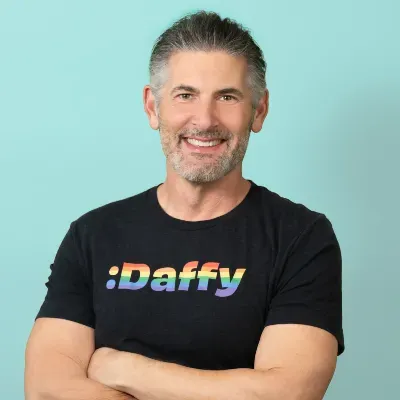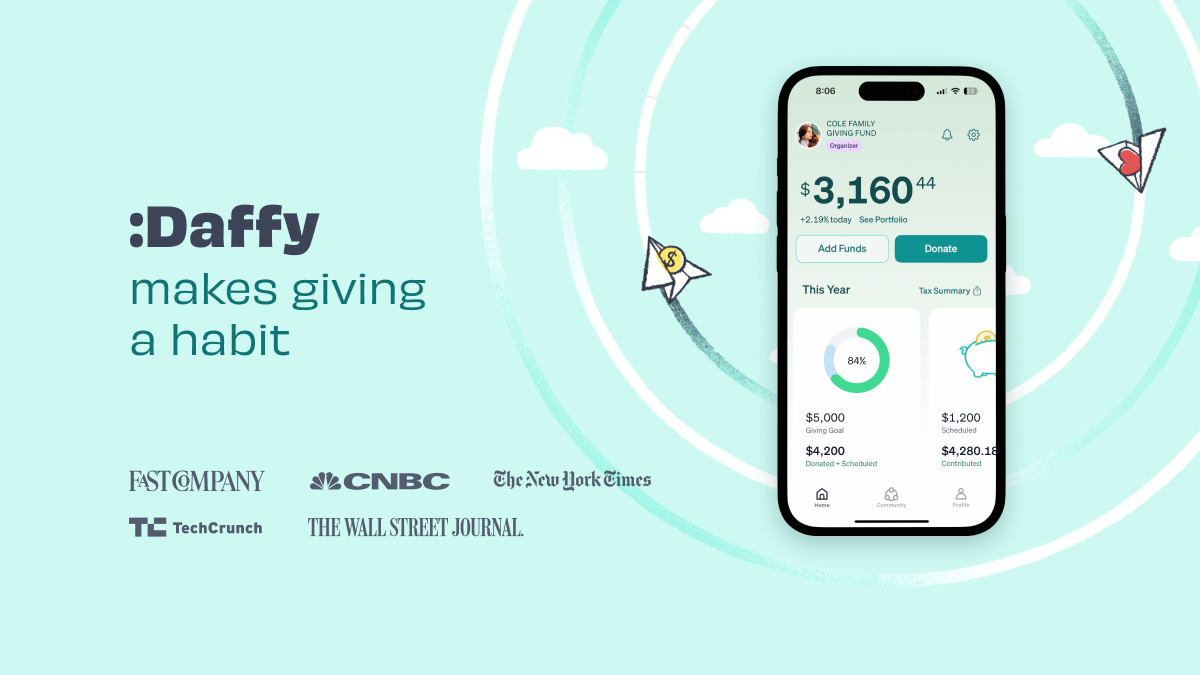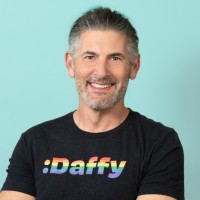Engineering Leadership Series - Adam Nash


Biography
Adam Nash is the co-founder & CEO of Daffy.org, a modern, fast-growing platform for charitable giving. Named one of Fast Company’s Most Innovative Companies of 2024, Daffy is short for the Donor-Advised Fund for You™. Adam has served as an executive, angel investor, and advisor to some of the most successful technology companies to come out of Silicon Valley. Adam previously served as President & CEO of Wealthfront. He has held executive and technical roles at Dropbox, LinkedIn, eBay, and Apple. Adam also serves as an Adjunct Lecturer at Stanford University, where he teachesU “Personal Finance for Engineers.” As an angel investor, Adam is well known for being an early investor in Firebase (sold to Google), Opendoor (Ticker: OPEN), Figma, Gusto, and over 150 other startups. Adam holds BS and MS degrees in Computer Science from Stanford University, as well as an MBA from Harvard.
More Information


The Interview
1. Tell us your story, how did you discover your interest in startups? Did growing up in Silicon Valley play a major role in shaping your personality?
While I grew up in Silicon Valley, both my parents are doctors, so direct involvement with engineering really happened in college for me. Still, you can’t escape the culture around building and innovation. Most elementary schools in the early 80s probably didn’t have access to Apple computers and BASIC programming classes, so there’s no question that being in the epicenter of the PC revolution helped. Probably the biggest influence, however, was just seeing these immense new companies and platforms being built, from nothing, by fairly ordinary people. Engineers who just were obsessed with the potential for what was now possible with new technology.
2. You’ve had a remarkable career across companies like LinkedIn, Wealthfront, Dropbox, eBay and Apple. You’ve also served on many boards and invested in over 100 startups. Growing up, did you expect that this would be your path? What has been most surprising to you about your journey so far?
Honestly, I didn’t have a detailed plan mapped out. I’ve always followed my interests, technology, personal finance, building meaningful products, and that led me through a series of incredible opportunities. Technology changes so quickly, you have to be ready to ask yourself every 2-4 years what would you do differently if you were starting today. What’s surprised me most is how diverse and fulfilling the journey has been. I never expected to be an angel investor in over 150 startups, or to find so much joy in teaching at Stanford. Each chapter has been unexpected in the best way.
3. Daffy is a modern platform designed to make charitable giving more accessible and habitual. What inspired your interest in philanthropy, and how did your personal values influence the vision behind Daffy?
At a very early age, all of my children went to a school where they were encouraged to bring in spare change every Friday, all to give to those in need. It made me think deeply about how we teach and practice generosity. As adults we often fall out of that habit, and in the midst of the COVID pandemic, Alejandro, my co-founder, and I became obsessed with a very simple, and yet ancient, idea. An idea that is the cornerstone of morality for billions of people, that everyone should put something aside for those less fortunate than themselves. That idea, combined with my passion for personal finance, made the idea behind Daffy click. I realized that we built incredible platforms to help people shop, save, and invest with just a few taps, the same level of technology and behavioral design just hadn’t been applied to giving. With Daffy, we set out to change that. The goal was to make charitable giving easier, more consistent, and more accessible to everyone, not just the ultra-wealthy, so that generosity could become a habit.
4. Daffy aims to make charitable giving a habit rather than an afterthought. What challenges have you faced in building a product around such a deeply personal behavior?
Giving is deeply personal, and building a product around it means respecting that emotional connection while also recognizing a behavioral truth: good intentions often aren’t enough. People want to give, but life often gets in the way - work, family, social life, etc. You often see the same struggle in saving for retirement. Imagine how few people would actually save for retirement if they didn’t have access to tools like a 401(k) that automate the process. That’s exactly what we’re up against in charitable giving. A large hurdle has been the misconception that donor-advised funds (DAFs), tax-advantaged accounts designed specifically for charitable giving, are only for the ultra-wealthy. Daffy is changing that by raising awareness among the 60 million households that already give to charity, offering a simple, flat monthly fee starting at just $3, with no AUM charges -- making DAFs accessible to anyone who wants to give regularly.
5. Are there any new features, partnerships, or initiatives at Daffy you're particularly excited about right now?
Absolutely! I’m really excited about the direction we’re heading with technology. One of the most powerful developments has been how we’ve integrated AI into the Daffy experience. We recently launched a feature called Quick Donate, built on Groq’s AI inference engine, that lets members simply say or type things like, “Give $100 to my local school in September,” and we handle the rest. It parses the amount, timing, and destination, and even recommends giving options based on your history and preferences. It’s like having a virtual philanthropic advisor—but for everyone. We’re also using AI in ways that enhance the experience behind the scenes, like enriching nonprofit data, flagging issues, and helping users generate campaign content when they launch fundraisers. Even little things like personalized thank-you messages go a long way in making giving feel more rewarding and human.
Another area I’m particularly passionate about is crypto. We've now facilitated over $40 million in crypto contributions, showing that digital assets aren't just speculative, they’re a real force for good. From integrating with Robinhood Crypto to supporting Bitcoin and Ethereum ETFs and enabling donations in over 200 crypto assets, we’re opening the door for a whole new generation of philanthropists.
And lastly, our APIs are a game changer. Developers and fintech partners can now plug into Daffy’s infrastructure to integrate charitable giving directly into their apps. Think about how you can save and invest on a platform like Betterment or Robinhood, we’re bringing that same embedded experience to giving. It’s about modernizing generosity and making it easy, habitual, and deeply integrated into people’s financial lives.
So yes, between AI, APIs, and crypto, we’re creating a platform that’s not only more accessible but genuinely reshaping how people approach charitable giving.
6. How can donors, both individuals and organizations, evaluate whether their giving is truly making a difference, and what tools or frameworks do you recommend for assessing philanthropic effectiveness?
One of the biggest mistakes that people can make, from a behavioral standpoint, is to try to solve the problem of which is the “best” organization to give their money and time to. It creates decision paralysis – too many choices lead to indecision and inaction. With over 1.7 million charities across the US alone, it is nearly impossible to find a universal definition of what cause or organization is “most effective.” My advice is to focus on the organizations and causes that authentically resonate with you, and give them your support consistently. Daffy makes it incredibly easy to set a goal for your giving, whatever it is, and then make it easy to set up recurring donations to whichever organizations inspire you.
7. What are the top 3 key lessons that you’ve learned from your time in Silicon Valley that have helped shape your personal philosophy?
Having traveled to many cities and countries around the world to work with entrepreneurs and investors, I have come to appreciate how unique Silicon Valley culture is. A few lessons that are worth sharing:
1) The best ideas can come from anyone. Out of over 150 angel investments, my best performing by far seems likely to be Figma. I met Dylan Field when he was an 18 year old intern at LinkedIn, where I was a VP. In technology, capabilities move so quickly that every 3-5 years, the question of “what is the best way to solve this problem?” can change radically. As a result, instead of focusing on hierarchical systems built around tenure and age, Silicon Valley tends to focus more on the ideas, thinking backwards from what we already know about the future in terms of technical capabilities.
2) Why now? It is such a deceptively simple question, and yet the clarity it offers is essential. The world is filled with people and companies with incredible reach and resources. There has to be a good reason that a persistent gap in the market exists that is large enough to build a new, venture-scale company. This was at the heart of what made Clay Christensen’s “The Innovator’s Dilemma” so transformational.
3) What game are you playing, and how do you keep score? There are so many books and frameworks about leadership, but in my career, this one has been the most durable. Too many leaders answer one of these questions, but not both. In Silicon Valley, the assumption is that you have a team of smart and ambitious people who want to succeed, but coordination of those talents and efforts is difficult. Intelligent people have a tendency to redefine goals to maximize their own chances of success. So rather than trying to implement a heavyweight command-and-control structure, the best leaders explain the long term strategic goals for the company, and empower their teams with data to align their efforts toward those goals.
8. How do you approach leadership? Are there certain things you try to do and certain things you try to avoid?
Leadership requires the hubris to believe that you can guide a team of talented people towards an exceptional outcome, and the humility to know that you personally don’t have all the answers. My personal style of leadership is very focused on providing clarity and purpose – harmonizing the team by collectively defining the most important problems to solve, while still empowering the team to explore and come up with novel solutions to those problems.
9. How do you typically hire a talented team?
The hardest part about hiring high quality people comes far before you ever write a job description or interview candidates. It requires thinking clearly about the person you want to hire, and more importantly, why would it make sense for that person to join your team? What are you offering them, not just today, but on the next leg of their professional journey? In most industries, that latter conversation devolves into specifics about title and compensation, but in Silicon Valley, that’s almost always insufficient. There are too many great companies with too much money to ever win a fight on dollars alone.
10. What advice would you give to aspiring entrepreneurs who want to build something meaningful that combines purpose and profit?
One of the most important attributes that I look at as an angel investor in seed stage companies is authentic founder-product fit. Building a great venture-scale company takes a decade or more. If you don’t have an intrinsic passion for the problem you are trying to solve, the market you are solving it for, and the solution you are building for that problem, it will be almost impossible to go the distance. Worse, you’ll have a serious challenge convincing other people who authentically care about the problem to work with you on it.
11. When you’re 80 looking back, what do you want to have accomplished in your life?
Well, if you asked this question to me ten or twenty years ago, I likely would have given different answers. Uncertainty about the future isn’t a problem to be solved, it’s a gift of agency and opportunity. But we all only get a limited time on this planet, so this question is one of the most important ones to ask. For me, life is much more about people. The family we build, the friendships we make, and the people we work with along the way. Ironically, this is one of the first things that I learned in Silicon Valley. Technology platforms and hot companies come and go, but relationships can last a lifetime. The fun thing about life in technology is that the more agency you show pursuing your interests and passions, the easier it turns out to be to find and connect with other incredible people.
We hope you enjoyed this interview. If you would like to be featured in a future interview, please contact our team at innovationinsider@donestreet.com.
To learn more about DoneStreet and why our customers love us, follow this link.
Spend Less Time Hiring, More Time Building. Hire With Confidence Through DoneStreet.
If you have not yet subscribed, please hit the subscribe button and let us know what types of content you’d like to see more of in the future.
Thanks for reading Innovation Insider - Presented by DoneStreet! Subscribe for free to receive new posts and updates.



